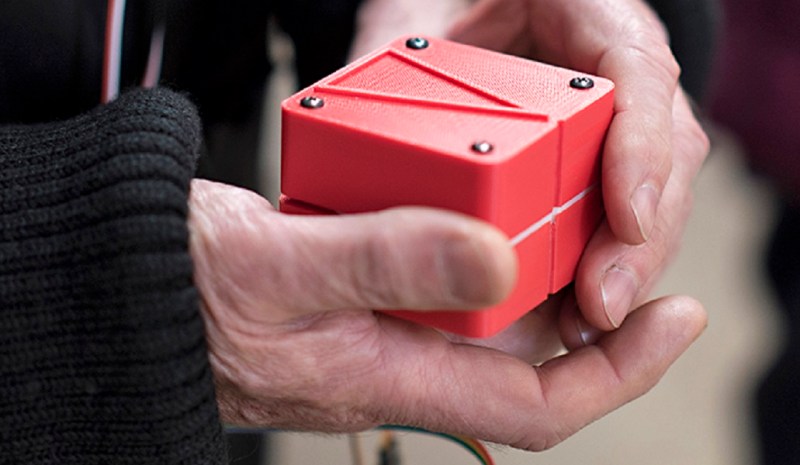The “absorbed device user” meme, like someone following Google Maps on a smart phone so closely that they walk out into traffic, is becoming all too common. Not only can an interface that requires face time be a hazard to your health in traffic, it’s also not particularly useful to the visually impaired. Haptic interfaces can help the sighted and the visually impaired alike, but a smart phone really only has one haptic trick – vibration. But a Yale engineer has developed a 3D printed shape-shifting navigation tool that could be a haptics game changer.
Dubbed the Animotus by inventor [Ad Spiers], the device is a hand-held cube split into two layers. The upper layer can swivel left or right and extend or retract, giving the user both tactile and visual clues as to which direction to walk and how far to the goal. For a field test of the device, [Ad] teamed up with a London theater group in an interactive production of the play “Flatland”, the bulk of which was staged in an old church in total darkness. As you can see in the night-vision video after the break, audience members wearing tracking devices were each given an Animotus to allow them to navigate through the interactive sets. The tracking data indicated users quickly adapted to navigation in the dark while using the Animotus, and some became so attached to their device that they were upset by the ending of the play, which involved its mock confiscation and destruction.
Performing art applications aside, there’s plenty of potential for haptics with more than one degree of freedom. Imagine a Bluetooth interface to the aforementioned Google Maps, or an electronic seeing-eye dog that guides a user around obstacles using an Animotus and a camera. There’s still plenty of utility in traditional haptics, though, as this Hackaday Prize semi-finalist shows.
















Marvelous, absolutely marvelous. I’ve been waiting for ideas like these. I’m not fan of the Apple Watch per se. I think the tiny screen makes it impractical for most purposes. But I do think that, in their efforts to make it functional, Apple stumbled on some haptic feedback ideas that could have great potential.
As a insult to those you’re meeting with, looking at your Apple watch when every text message comes in is no better than looking at your iPhone. But a specific vibration that tells you and you alone that a certain message has come in could be socially acceptable.
Or as a guide to getting about like the above device, people navigating about a city on foot, would not have to keep looking down at their smartphone. Their turns could be signaled by a haptic bracelet on their wrist or foot. A vibration on the right would mean to turn right at the next corner. That sort of thing.
And that would achieve the grand goal of every tourist—an ability to get about a strange city without looking like a foolish tourist who must keep looking down at a map or smartphone.
I wonder if it’s possible using haptics and some fancy multiplexing to make it feel like you’re being pulled toward your destination. I imagine one of those belts studded with pager motors using them to trick the body into feeling like a rope is pulling you a certain direction.
Not really any more practical than a single buzz in the intended direction, but a cool trick IMO.
Thanks for the great feedback Michael!
Funny you say that: I have a very basic Xaomi Mi fitness bracelet and it’s really cool feature is a haptic motor. It has no screen, just the motor and 3 LEDs. The phone App, however lets you do some stuff with these features:
1. set an alarm that buzzes the bracelet. I can wake up early for work and not disturb my wife or others
2. Buzz when the phone is ringing (and display a customer LED color different that the device status LED color).
3. Apparently with Xaomi and Android phones, you can also set up buzzing for text messages and possibly other alerts (I have an iPhone so not really sure)
With access to the API, one could easily cycle the LEDs Left to Right or Right to left to indicate a direction and/or use different colors to indicate forward or backward.
Oh yeah, by bracelet tracks speels so I can see how well I slept (or didn’t at night) and counts “steps” (not that impressed with the accuracy). The think is, due to the minimal interface, it was able to be enclosed and IP-67 rated, so it’s mostly waterproof and dustproof. It also lasts around 40 days on a charge (it’s helpful to not have to recharge every night when you are trying to track sleep).
I think small haptics are the future.
Someone should program a WatchYourStApp for smartphones that tells users when obstacles appear and what to do (stop, duck, jump, return to reality…).
There’ll be always one camera pointed to the floor to do OpenCV on…
‘…became so attached to their device that they were upset by the ending of the play, which involved its mock confiscation and destruction’. So they’ve made us a Companion Cube then?
A similar device that is a hands free ankle bracelet allows the user to know which way north is using an array of vibration motors. This could be modified to pulse navigation directions as well. http://sensebridge.net/projects/northpaw/